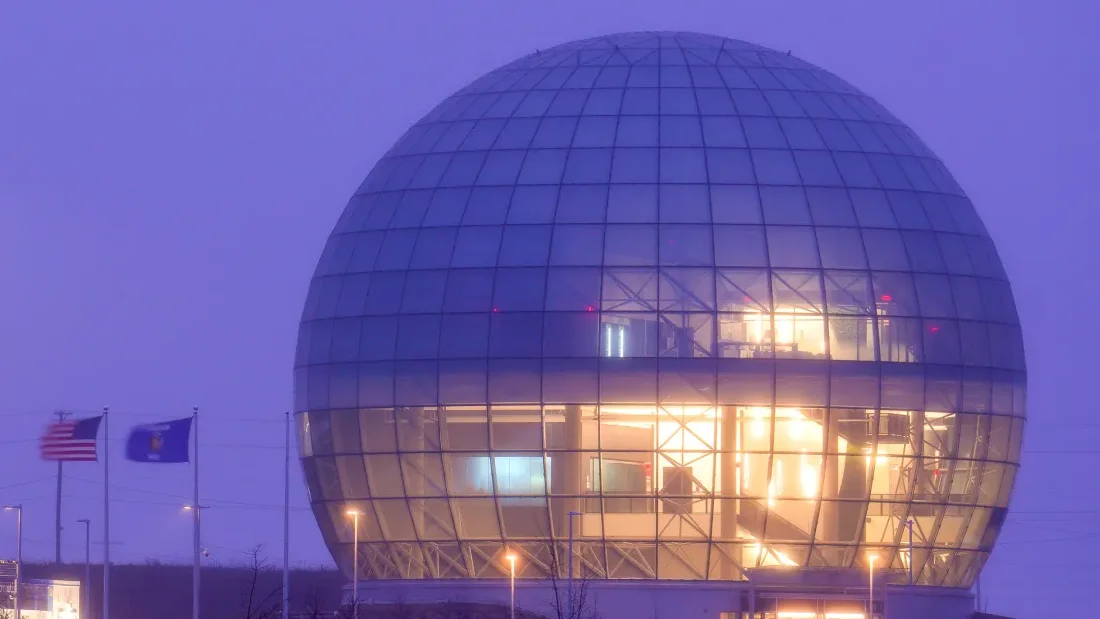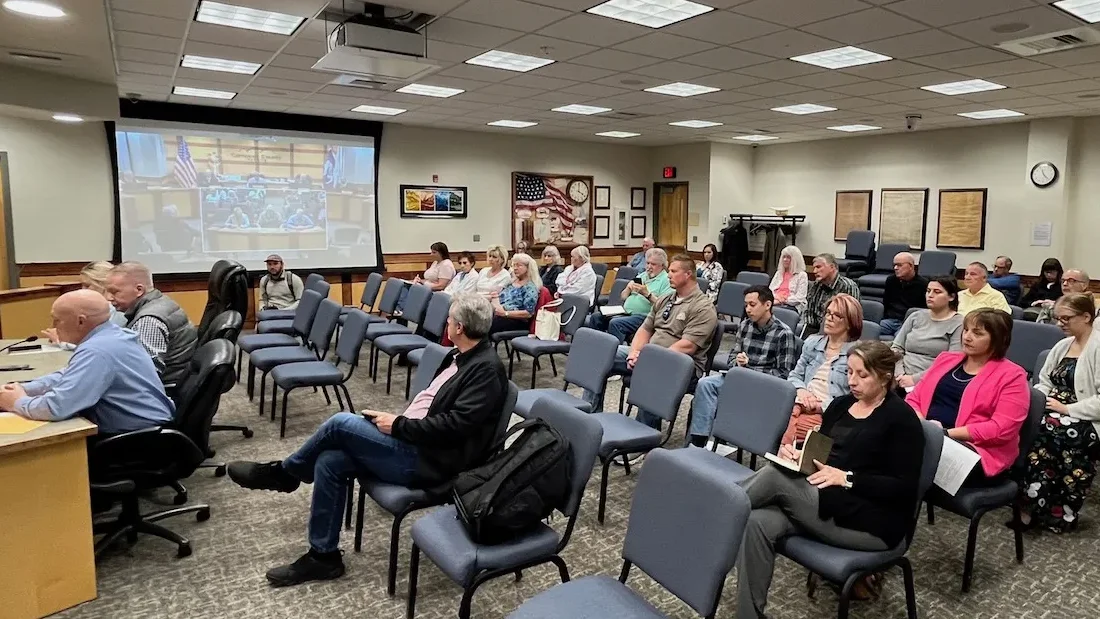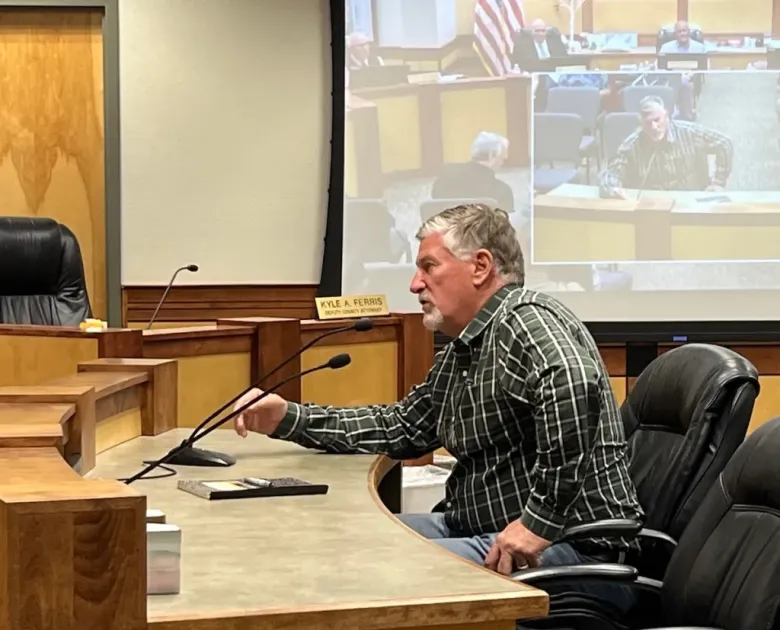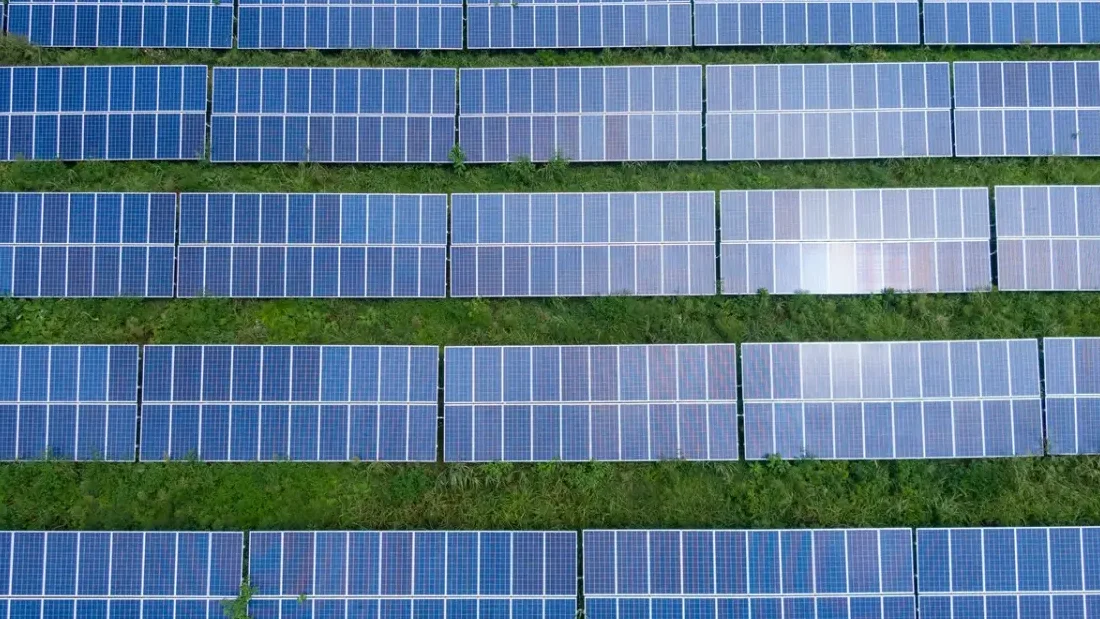
Southeastern Wisconsin and the Chicago area are emerging as major players in the national data center explosion, most notably with Microsoft’s $3.3 billion planned data complex near Racine, Wisconsin.
Clean energy advocates in the region say data centers pose both a risk and an opportunity, as they can put major stress on the grid, prolong the lives of coal plants and spark new natural gas plants, but also facilitate significant renewable energy investment. Wisconsin utility We Energies, for example, cited demand from data centers in its recent requests to the Public Service Commission for 1,300 MW of new gas generation. Microsoft, meanwhile, has promised to build renewables in the state while also likely creating demand for new or continued fossil fuel energy.
The organization Data Center Map shows more than a hundred data centers in the Chicago area and a handful in Southeastern Wisconsin, often located on the site of former coal plants or industrial operations. A data center is underway on the site of the shuttered State Line coal plant just across the border from Chicago in Indiana. The data center developer T5 recently announced plans for four to six data centers totaling 480 MW of capacity and costing as much as $6 billion in the Illinois town of Grayslake near the Wisconsin border, adding to data centers it already runs in the region.
Virginia has long been known as “Data Center Alley,” with about 70% of global internet traffic passing through its servers, according to the Wall Street Journal. Dominion Energy said that because of data centers, its electricity demand in Virginia could quadruple and represent 40% of total demand in the state over the next 15 years. Georgia and Tennessee have also seen much data center construction and speculation. Utilities like TVA, Duke and Dominion have announced plans to build more gas plants and keep coal plants open longer in that region, along with building renewables.
Meanwhile, some experts say the Great Lakes region is an increasingly promising spot for data centers because of its cooler climate that reduces energy demand and the availability of water.
“There is no better place” for data centers than the Upper Midwest, said Josh Riedy, who helped design North Dakota’s first tier-three data center, referring to a data center with high reliability — on a scale of one to four tiers — that includes multiple power sources. Riedy also founded Thread, a grid maintenance software company that he’s marketing as especially helpful to serve data center demand.
“The Upper Midwest can export data around the globe,” Riedy said. We’re starting to see the tide turn, it’s just natural.”
Projections abound regarding the way data centers — including those processing cryptocurrency and running AI applications — will increase energy demand nationally and end an era of stagnant load growth.
Last year, the Federal Energy Regulatory Commission predicted 4.7% load growth over the next five years, up from 2.6% previously estimated for five-year growth. Data centers “supercharged by the rise of artificial intelligence” will require between 9 and 13 more GW of electricity over the next five years, according to seven case studies analyzed in a December 2023 report by the Clean Grid Initiative, which does not include data center estimates for MISO or CAISO (California) regional transmission organizations. A McKinsey & Company report predicted 35 GW of total demand from data centers by 2030.
Load growth sparked by data centers comes on top of a shift from fossil fuels to electric heating, cooling and transportation. A 2022 report commissioned by Clean Wisconsin and RENEW Wisconsin found load growth could increase to 166% of 2022 levels with building and vehicle electrification needed to meet the state’s goals of net-zero emissions by 2050.
“Everything from data centers to manufacturing to AI to cryptocurrency,” said Sam Dunaiski, executive director of RENEW Wisconsin. “These all could be triggers for new load, and it all could be coming to Wisconsin, though it’s not unique to Wisconsin. Things like solar and battery manufacturing are coming online that ironically need new load growth too. We think the best way to meet that new load both environmentally and economically is through renewables and transmission to go along with it. This is a great opportunity for a low-cost renewable energy boom in the state.”
Along with the generation demand, Riedy noted, come needs for grid updates and resiliency, which can ultimately help the grid as a whole.
“If you’ve built and designed a data center, you know the nature of them is in many ways fundamentally different than most energized structures,” Riedy said. “Walmart, for example, is going to consume power, but it will have peaks, and constant power is important but not in the way it is to a data center. With crypto mining or AI model training, you see machines running at near peak performance around the clock. That’s producing a type of strain on the grid that has few comparisons.”
Microsoft’s energy plans — like many details about the massive data project — are not yet clear, and the company’s ambitious climate goals give advocates hope that the company will finance much new renewable generation either on-site or through power purchase agreements. The company has announced it will build a 250 MW solar array in Wisconsin.
But Microsoft will likely also purchase power from We Energies, fueling advocates’ worries about new natural gas generation and rate increases for regular customers.
The data center will be located on the sprawling site between Milwaukee and Chicago that was previously slated for an enormous LCD screen factory by the company Foxconn. That plan was repeatedly scaled back and then scrapped in the face of economic issues and local opposition.
Citizens Utility Board executive director Tom Content noted that “under state law passed for Foxconn, Microsoft is eligible for discounted market-based electricity rates. They would pay basically for the transmission and distribution, but a portion of their rates would just be set at wholesale market rate,” rather than the retail amount customers usually pay.
In February, a subsidiary of We Energies filed a plan with the Wisconsin Public Service Commission for an estimated $304 million in grid upgrades related to the Microsoft project. Public auditors filed a letter with the commission noting exemptions that allow less oversight because the project is in a special technology zone.
The Microsoft plan was touted by President Joe Biden as an example of reinvigorated Midwestern investment, but it has faced concerns about its energy and water use. Meanwhile Microsoft has faced setbacks globally in reaching its climate goals, in part because of the massive energy demand of artificial intelligence applications.
Advocates said utilities may use data centers to justify more investment that earns them a rate of return, even when it is not necessarily needed.
“We are concerned that there could be an overinflation of expected demand in order to capitalize on this trend and build more gas as a last-ditch effort,” said Ciaran Gallagher, energy and air manager for Clean Wisconsin.
“There’s a little bit of a sky-is-falling scenario here,” Dunaiski agreed. “In the early 2000s we saw this with load growth [projections] particularly around the internet. People thought the internet would cause our electricity generation needs to explode. They increased, but there were improvements that came with it — infrastructure getting more efficient, and software.”
That precedent raises questions about the rush to build out gas power to accommodate projected demand.
“Gas isn’t coal, but we shouldn’t be striving for the second worst option, for the environment or for our pocket books,” Dunaiski continued. “If we build these gas plants, customers will be paying for them for the next 20, 30 years.”
Gallagher noted that the EPA’s new rules for gas plants make new gas investments even more questionable.
“All the gas plants proposed in Wisconsin and across the country in relation to this demand from data centers will have to comply with these standards, and by 2032 either run not very often or reduce greenhouse gas emissions by 90% through carbon capture and sequestration or low-carbon hydrogen,” Gallagher said. “That prompts the question: Is it worth the price tag to build these gas plants that could become stranded assets or have to spend additional money to comply with these rules?”
Using existing renewables or zero-emissions nuclear energy to power data centers can impact customers too. Content noted that this strategy “accomplishes the decarbonization goals for the tech companies and the reliability needs for the data center. But then you’re taking the fully depreciated, mostly paid-off asset on utilities’ books and having it serve one or two customers, and then the utilities will have to backfill that with a combination of natural gas, solar, storage, wind or future nuclear to serve the rest of the customers.”
“It’s on everybody’s mind how we’re going to tackle this in a way that ensures we don’t say no to economic development, but don’t make energy costs unaffordable,” said Content, noting that data centers have been a major topic of discussion among the National Association of State Utility Consumer Advocates – including at the organization’s conference in Madison in June.
“Different states are trying different approaches,” Content said. “There’s talk of changing the way utility costs are divided up — currently among residential, industrial and commercial — and dividing it up four ways, with data centers becoming their own entity. Tech companies are pouring a lot of money into the development of these things. They have the wherewithal to contribute mightily to these projects.”
Gallagher emphasized that renewable advocates are not opposed to data centers.
“We think data centers and the economic development that they can bring are not at odds with environmental protection and climate mitigation,” she said. “This can be a low-carbon industry but only if new additional renewables are built to supply all or most of their demands. We think that’s viable if renewables are cost-competitive with gas, and pairing renewables with storage can provide the type of reliability these data centers need.”
Riedy sees renewables and gas as a necessary mix to fuel data centers. While renewables’ intermittency might be seen as a barrier, he said renewables actually could have a unique role to play in energizing data centers – especially in the Midwest.
“In the heat of the day you’re delivering, so having alternate [energy] sources to peak-shave and normalize the cost of energizing that equipment is very important,” Riedy said. “It’s leading to a change in thinking around where to place data centers, that speaks to Wisconsin, the Dakotas.
“The old way of doing things was generate power in one place, and transmit it for thousands of miles. What data centers are understanding with their insatiable and constant need for power is they are more logically placed by power generation so you can buy that off-peak power, to maintain that load consistently. Since solar and wind overproduce [at certain times], if you can harness that imbalance it’s somewhat of a win-win.”

SOLAR: New Hampshire’s legislature fails to pass a bill to allow community power programs to use up to 5 MW of local solar projects after a state energy official writes that the measure “needs more thorough vetting.” (NHPR)
ALSO:
ELECTRIC VEHICLES:
PIPELINES: A federal circuit court denies the argument of an environmental group that federal energy regulators didn’t appropriately account for emissions or New York law when they approved a pipeline expansion project in that state and Pennsylvania. (Bloomberg Law, subscription)
GAS: A top Massachusetts lawmaker prepares a bill that would require consideration of less costly or polluting alternatives before authorization of new gas service extensions. (Boston Herald)
GRID:
POLICY:
TRANSIT:
CARBON CAPTURE: A Portland ocean carbon removal startup shuts down and lays off its employees, with its chief executive saying the voluntary carbon credits market had shrunk too much in recent months for the firm to stay afloat. (Portland Press Herald)
BATTERIES: New Hampshire legislators send a bill to the governor’s desk that would ban lithium-ion batteries from being disposed in regular trash to cut down on landfill fires. (New Hampshire Bulletin)
WIND: The first American-built offshore wind service operations vessel is unveiled in Providence, Rhode Island, to work on the nearby Revolution wind project. (WPRI)

CLEAN ENERGY: More than three quarters of the Inflation Reduction Act’s $34 billion of announced investments have gone to congressional districts represented by Republicans who voted against it, an analysis finds. (CNN)
ALSO: South Korean companies have invested in electric vehicle, solar panel and battery factories in Georgia that will employ the equivalent of small towns, and officials from both the U.S. and Korea are pushing for further collaboration. (Atlanta Journal-Constitution, subscription)
OIL & GAS:
FINANCE:
OVERSIGHT: Industry groups and clean energy advocates cheer the appointments of three new members to the Federal Energy Regulatory Commission that give the five-member body a full quorum. (States Newsroom)
GRID:
PIPELINES:
ELECTRIC VEHICLES: Electric construction vehicles are slowly catching on, but charging limitations, short battery lives, and other challenges still make them impractical for bigger jobs. (Washington Post)
CARBON CAPTURE: North Dakota landowners unwilling to lease property for carbon storage raise concerns about health hazards, a lack of economic benefit and unfair treatment from the project developer. (North Dakota Monitor)

It’s become a biannual tradition.
Since 2021, when North Carolina adopted a law requiring Duke Energy to zero out its carbon pollution, advocates have spent every other year poring over the company’s plans for supplying this state of 11 million with clean electricity.
As of late last month, the first phase of the new ritual is now complete: citizens turned out by the hundreds to public hearings around the state and submitted written comments; and dozens of organizations, businesses, and large customers filed testimony to the state’s Utilities Commission, charged with approving or amending Duke’s plan by year’s end.
A review of these comments shows clear dissatisfaction with Duke’s plan, which critics say is too reliant on gas and unproven technologies and too dismissive of resources like solar and battery storage.
But there are also a few powerful institutions pulling in the opposite direction. And their voices could grow louder in the coming months, as the state enters the next phase of in-person, expert witness hearings.
The law requires Duke to cut its carbon pollution by 70% by 2030 and at least 95% by midcentury, in line with scientists’ recommendations for avoiding catastrophic global warming. The statute directs regulators on the Utilities Commission to develop a plan to make that happen and to update the blueprint every two years.
Even as the popular, bipartisan measure moved through the legislative process, some critics worried it gave too much deference to Duke and did not make clear that regulators — not the utility — would chart the state’s path to a decarbonized electricity sector.
Still, after Duke in 2022 issued its first Carbon Plan proposal — a document covering hundreds of pages and including four different pathways for achieving net zero — a host of outside stakeholders put forward their own plans for the commission to mull, hoping the panel would pick and choose from them or even craft its own blueprint.
But in the end, after months upon months of expert hearings, public input, and thousands of pages of written testimony, the commission adopted Duke’s plan with few edits.
This first Carbon Plan order was largely nonbinding. But after regulators sided with Duke on virtually every major issue — from how much the company should drive energy efficiency to how much solar it can connect annually to the grid — advocates this year are taking a slightly different tack.
Rather than devise their own painstaking models to compete with Duke and its army of lawyers, engineers, and other experts, this time most organizations are starting with the company’s portfolios and critiquing key elements.
As in the lead up to the first Carbon Plan, this year Duke has proposed multiple routes to zero carbon by midcentury, with one clear preference. Offered in January after predicting a steep rise in electricity demand, that pathway is to add over 22 gigawatts of renewable energy and battery storage in the next decade, including from ocean-based wind turbines.
In the same time frame, the company wants to shutter most of its coal plants and add nearly 9 gigawatts of new gas plants, nearly three times the immediate build-out it proffered two years ago and one of the largest such proposals in the country. It also envisions two small nuclear plants of 300 megawatts each, about a seventh the size of the state’s largest nuclear plant outside Charlotte.
The company seeks to exploit exceptions in the state’s law to achieve a 70% cut in carbon emissions by 2035 instead of 2030. And while its plans to zero out its pollution are vague, they rest partially on building more nuclear reactors by 2050 and fueling any remaining gas plants with hydrogen – a technology still under development.
Still, Duke’s focus is on the immediate term. In its January filing, it sought support for “pursuing near-term actions that align with [its preferred pathway] as the most reasonable, least cost, least risk plan to reliably transition the system and prudently plan for the needs of…customers at this time.”
Numerous commenters questioned that assertion, including the company’s premise that ratcheting down emissions more slowly than the law prescribes presents a “lower execution risk.”
Perhaps most notably, the Clean Energy Buyers Association, a group of 400 major corporations from a range of sectors with their own sustainability targets, argued forcefully against delaying the 2030 target.
“The ability of [our] members that are Duke customers to meet their clean energy commitments depends in large part on how clean Duke’s resource mix is,” the association’s Kyle Davis said in written testimony. He went on to say regulators should “only” approve a near-term plan that would allow Duke to cut its pollution 70% by decade’s end.
Similarly, a group of local government Duke customers with climate goals, including major cities Raleigh and Greensboro and small college towns Boone and Davidson, noted that Duke’s energy mix would dictate whether they could meet their aims.
“Due to the urgency of the climate crisis and the implications to the health and well-being of the constituents we serve,” the cities and counties wrote, “it is imperative that the 2030 target be met in the timelines specified in [the law.]”
Testifying for the office of the Attorney General Josh Stein, expert witness Edward Burgess noted that the commission has not yet abandoned the 2030 deadline and that, according to the law, the 70% cut could only slip past 2032 under “very specific conditions” that have not been met.
Regulators haven’t authorized a nuclear or wind project that has been delayed beyond Duke’s control, he asserted, and a delay wasn’t necessary to maintain the “adequacy and reliability of the existing grid.”
Recognizing Duke’s latest increased demand projections, Burgess urged commissioners to “set a clear directive for Duke to achieve the Interim Target by no later than 2032.” Otherwise, said the witness for the attorney general, the public interest would be harmed by the “increase [in] the cumulative tons of CO2 emitted, which would remain in the atmosphere for hundreds to thousands of years.”
The process by which Duke maps its generation plans over the next decade is complex and time intensive. But it’s aided by a computer modeling program that weighs various factors including costs to produce an optimal generation mix.
This method produces more solar and battery storage each year than Duke thinks is possible or appropriate to connect to the grid, so the company imposes manual limits on the computer program. Critics call that step unnecessary and damaging to the project of curbing carbon emissions in a least-cost manner.
“Solar [photovoltaic] is the cheapest source of carbon-free electrons on the grid now and for the foreseeable future,” testified expert witness John Michael Hagerty on behalf of the Carolinas Clean Energy Business Association. “All things being equal, the more generation… that Duke can get from solar PV instead of other resources, the cheaper it will be for Duke to comply with carbon reduction targets.”
Michael Goggin, an expert witness for the North Carolina Sustainable Energy Association and clean energy groups represented by the Southern Environmental Law Center, analyzed other grid operators around the country and estimated that Duke could connect around 4 gigawatts of solar and storage annually, compared to the upper limit of 2.8 gigawatts suggested by the utility.
“Duke’s arbitrary limits on solar and battery interconnection should be greatly increased if not eliminated,” Goggin wrote. “These limits do not reflect reality, and there are many potential solutions to the interconnection challenges Duke claims in its attempt to justify these limits.”
While numerous commenters were happy to see Duke move much more ambitiously toward offshore wind than it did two years ago, they noted the utility’s projected 2.4 gigawatts — enough to power about a million homes — fell significantly short of the near-term potential in ocean wind areas off the state’s coast.
“The Carolina Long Bay projects have the potential to reach more than 2 gigawatts, and the Kitty Hawk Projects have the potential to reach nearly 3.5 gigawatts,” two employees of wind company Avangrid testified. “Therefore, there is additional offshore wind resource beyond the Preferred Portfolio request available to North Carolina.”
The state’s Department of Commerce has taken a keen interest in offshore wind because of its vast potential for economic development. Jennifer Mundt, an assistant secretary at the Department, implored regulators and Duke to “set a path forward… that directs the deployment of at least 6.0 gigawatts of offshore wind by the mid-2030s.”
Such development is achievable with the Carolina Long Bay and Kitty Hawk areas, she said, and “will unlock billions in capital expenditures and tens of thousands of good-paying jobs for North Carolinians, and boost Duke towards its mandate to achieve carbon neutrality by mid-century – a true win-win-win scenario.”
A pair of experts testifying for the North Carolina Sustainable Energy Association noted that Duke would benefit from being a “second mover” on offshore wind in the United States: it could learn from the many other projects underway on the Eastern seaboard without putting ratepayers at risk.
In contrast, John O’Brien and Philip Moor warned that for small modular nuclear reactors, “it is unclear when the Companies will be a second mover… the only approved project design…has been cancelled, and the closest designs… are under development by TerraPower and the Tennessee Valley Authority.”
Indeed, while most clean energy advocates believe large, existing, emissions-free nuclear power plants can play a vital role in curbing carbon pollution, several say Duke’s near-term pursuit of as-yet unproven small modular reactors over more readily available alternatives is a mistake.
“Given the long lead-times, nuclear experts have found that [small modular reactors] will do nothing to address climate change, as the technology is too little, too late,” Grant Smith, senior energy policy advisor with Environmental Working Group, testified on behalf of his group, Durham nonprofit NC WARN, and others.
Numerous stakeholders criticized Duke’s plan to build 10 new gas plants in the next decade, half of which would be large baseload plants forced by new federal rules to run 40% of the time or less. Not only would Duke customers be on the hook for these underutilized plants, critics argued, they’d also be subject to erratic fuel prices.
“In North Carolina, this volatility was at the heart of hundreds of millions of dollars of recent fuel cost increases approved by the commission,” expert witness Evan Hansen testified on behalf of Appalachian Voices. “The Companies’ proposed aggressive build-out of natural gas-fired power plants will only increase their exposure, and their ratepayers’ exposure, to the future volatility of natural gas prices.”
The company’s strategy of converting gas plants to run on hydrogen molecules separated from other compounds as late as 2049 also strains credulity for some.
“Duke’s general plan to build new natural gas-firing facilities and then transition those facilities to 100% hydrogen-firing faces significant technical uncertainty, infrastructure hurdles and costs,” testified William McAleb for the Environmental Defense Fund. The plants, he said, “are not necessary to maintain grid reliability, may never be co-fired with hydrogen, and will likely raise rates.”
The Clean Energy Buyers Association also suggested that Duke’s plan to supply its members with gas-fired electricity could backfire, causing the state to lose economic development projects and the utility to lose new customers.
“Some of the new load that Duke is forecasting may not materialize if Duke increases the carbon intensity of its resource mix as it has proposed to do in this docket, since some of the customers bringing new load… have clean energy targets,” the association’s Davis wrote.
If that happens, he said, “and Duke overbuilds with fossil fuel capacity, it would result in higher costs for existing customers and make it more difficult for existing customers to meet their sustainability targets.”
Amid all this criticism, support for Duke’s approach stood out, especially where the timeline is concerned.
Testifying for the Carolina Industrial Group for Fair Industrial Rates, a powerful consortium of manufacturers and other large Duke customers, Brian Collins asserted, “there is increased cost and risk in reliably meeting the interim 70% target by 2030. As a result, I recommend that the Commission not require Duke to meet the 70% emission reductions target by 2030.”
Public Staff, the state-sanctioned ratepayer advocate, believes that compliance with the interim pollution cut is possible by 2034 but not before. And the state’s 26 electric cooperatives, which buy electricity wholesale from Duke, expressed some concern about the speed of transmission upgrades necessary to add renewable energy to the grid fast enough.
A technical conference is scheduled for next week in Raleigh, and what is likely to be weeks of expert-witness hearings begin July 22.

GILLETTE—The Biden administration’s proposal to end federal coal leasing in the Powder River Basin will have “grave” and “drastic” consequences for Campbell County, the nation’s largest coal supplier and a bulwark of Wyoming’s economy for the past 50 years, residents and local officials say.
If implemented, the proposal will destroy the livelihoods of thousands of miners and their families here and gut the community’s economy, Gillette resident George Dunlap said.
“We have to stop the Biden administration from destroying it because they will. We can’t sit back and say ‘What’s going on?’”
Dunlap, who owns and operates a photography business in Gillette, was among several speakers to address the Campbell County Commission on Tuesday. The commission solicited public testimony during its regular meeting to accompany a formal protest letter opposing the Bureau of Land Management’s proposal.
The five-member commission is hoping to rally a massive outpouring from the public and is encouraging the state to take immediate legal action to stop the BLM from banning federal coal leasing.

“The effects it’s going to have on this local community are going to be grave, and we need to fight,” Commission Chairman Del Shelstad said.
But the commissioners’ efforts to solicit testimonials garnered participation from only a handful of residents Tuesday — a disappointment for the body, even considering the shift-work nature of this blue-collar community and the 11 a.m. weekday timing of the hearing. Residents who spoke were outnumbered by other elected officials and reporters.
The coal industry — which includes 10 active mines in the county and directly employs more than 3,000 workers here — was a no-show.
Shelstad asked whether there were any coal producers or representatives of coal mining companies in the room. There were none, which elicited a frustrated response from Shelstad.
“I think that’s a darn shame that the coal producers aren’t here fighting — if for nothing else, for their employees,” he said. “They’re probably going to have a strategy that takes a little different approach, and I’m OK with that. But it’s really shameful that we can’t get them here to make public comment and to enter this fight with us.”
The public comment hearing was organized in response to what many regard as a historic move by the Biden administration to effectively set an expiration date for one of the nation’s largest sources of electrical power generation, as well as planet-warming greenhouse gas emissions: Powder River Basin coal.
The BLM on May 16 announced its preferred “no future coal leasing alternative” in a federal court-mandated update of its land use plans for the Buffalo, Wyoming and Miles City, Montana field offices that oversee coal leasing in the Powder River Basin, which spans portions of both states. Conservation groups had successfully argued the federal agency must fully consider the environmental, climate and human health implications of leasing federal coal in the region.

In its proposal to ban further federal coal leasing, the BLM estimated that existing leases will support the current rate of Powder River Basin coal production to 2041, according to the agency.
Cooperating agencies — such as local and state governments in the region — have until June 17 to file letters of intent to protest the BLM’s preferred no future leasing alternative. That gives those entities legal footing to challenge the decision. In addition to filing a protest letter, Campbell County commissioners are circulating an online petition urging the BLM to reconsider its preferred alternative.
“The coal industry employs thousands of workers across the country, and this ban will put many of these jobs at risk,” the petition states. “Additionally, coal is a vital source of baseload electricity for millions of Americans. Without a reliable supply of coal, our nation’s energy grid could become unstable.”
As of Wednesday morning, the county had collected 455 petition signatures, according to officials. Shelstad said he hopes to eventually collect at least 20,000 signatures.
Coal proponents in Wyoming say the BLM’s coal leasing ban is the latest in a series of Biden administration actions designed to kill the industry in favor of renewable energy sources and an effort to appeal to voters concerned about the global climate crisis.
The U.S. Environmental Protection Agency in April issued four “final” rules aimed at drastically cutting coal pollution, including a mandate that operators of existing coal-fired power plants commit to cutting or capturing 90% of the planet-warming carbon dioxide emissions by 2032 or convert the facilities to natural gas or close altogether.
Those coal-fueled power plants represent nearly the entirety of the Powder River Basin coal market today.
Energy market analysts, along with conservation groups, have suggested that the administration appears to be issuing rules and compliance deadlines that follow market trends already in motion, noting that many utilities are moving up coal plant retirement dates and that mining companies have not nominated a major new federal coal lease in the Powder River Basin since 2012.
Market trends have already cut production in the region by half since 2008, and the decline in demand for Wyoming coal appears to be accelerating — down by 20% so far this year. In fact, one of the region’s biggest coal producers, Arch Resources, has said it plans to sell or close its two coal mines in Campbell County: Coal Creek and Black Thunder.
Rep. John Bear (R-Gillette) and other local elected officials assured commissioners that they’re hearing pleas from their constituents to use every resource to fight the federal rules. If there is a lack of presence among coal companies themselves, Bear told WyoFile, it might be attributed to years of bad news and mounting pressures on the industry.
“The local [mining companies], most of those boards are located in St. Louis [Missouri] and they’re not interested in fighting this fight the way we’re going to have to fight it as government entities,” Bear said.

Wyoming Mining Association Executive Director Travis Deti, who could not attend the meeting, has said the mining companies rely on the association to speak on their behalf in the state, as well as other advocacy groups at the national level.
“As far as the Mining Association, which represents those companies, we’re fully engaged with our congressional delegation, with the governor’s office, with the Legislature, and we’re using every tool at our disposal to try to fight back on some of this stuff,” Deti told WyoFile by phone on Wednesday.
Some state and local officials are skeptical that the market has already spoken louder than the Biden administration. While some companies such as Arch Resources might not anticipate a future in Powder River Basin coal, others see an opportunity to apply carbon capture technologies and coal-to-products manufacturing — all of which is under threat by the BLM’s no future leasing proposal, according to Bear.
“Even if we’re forced to do it alone, other investors will see an opportunity,” Bear told WyoFile. “They have to see that somebody is fighting back right now.”
Bear said he worries that even some in Campbell County might not be aware of future opportunities for coal, or the dire consequences if the industry goes away completely.
“The rest of the country is going to be in trouble, too,” he said, adding that the rapid move to shut down coal plants presents an electric reliability issue. “Reliability is absolutely critical and that’s what this stuff provides.”
Though most coal miners and residents here squarely pin the blame for the coal industry’s decline on the Obama and Biden administrations, they’ve been burned by coal companies in the past.

Most infamously, Blackjewel in July 2019 abruptly closed its Eagle Butte and Belle Ayr coal mines — among the nation’s largest — leaving some 600 miners in limbo about whether they could return to work or collect paychecks. The company furloughed many workers and eventually brought others back as both mines resumed operations. But the company’s unannounced mine closures and subsequent bankruptcy left coal miners as well as local businesses and governments fighting to get paid for wages and taxes owed.
Arch Resources (then Arch Coal) and Peabody Energy separately announced massive layoffs on the same day in March 2016, cutting jobs for some 500 miners. Both companies subsequently shed billions of dollars in debt in Chapter 11 bankruptcy reorganizations.

NUCLEAR: Pacific Gas & Electric disputes advocates’ claims that operating the Diablo Canyon nuclear plant until 2030 will cost $12 billion as California lawmakers propose canceling a $400 million loan for the facility. (Newsweek, Associated Press)
SOLAR:
WIND: Developers bring a 152 MW wind facility online in southeast Idaho. (Idaho State Journal)
BIOFUELS: Northwest advocates look to block a proposed wood pellet plant’s air quality permit, saying regional regulators underestimated the Washington facility’s potential harmful emissions. (news release)
CLIMATE: A civil grand jury finds San Francisco lacks a comprehensive funding plan for climate adaptation and existing infrastructure is inadequate to handle worsening floods. (Los Angeles Times)
OIL & GAS:
PUBLIC LANDS:
CARBON CAPTURE: A Western governors’ group urges the Biden administration to “promote not impede” carbon capture deployment at power plants. (WyoFile)
TRANSITION:
COAL: Documents reveal Utah Gov. Spencer Cox ignored pleas from more than a dozen local officials and agencies to veto legislation aimed at taking ownership of an aging coal plant to keep it operating beyond its scheduled retirement. (Salt Lake Tribune)

CLEAN ENERGY: Local and state opposition to renewable energy projects is “widespread and growing,” with local governments putting 55 new moratoriums, bans, and other restrictions in place in the last year, Columbia University researchers find. (Utility Dive)
OVERSIGHT: The U.S. Senate confirms three nominees to the Federal Energy Regulatory Commission, filling the five-member board as it prepares to guide the nation’s grid buildout. (E&E News)
ELECTRIC VEHICLES: Oil and gas industry trade groups sue the U.S. EPA over its strengthened tailpipe emissions rules meant to drive electric vehicle manufacturing and sales. (The Hill)
GRID: Residential distributed energy resources like electric vehicles and at-home battery storage systems could allow utilities to meet growing power demand through 2035 without new generation, a consulting group finds. (Utility Dive)
SOLAR:
NATURAL GAS:
POLITICS: Former President Trump spent a third of his time on Capitol Hill this week talking about energy, a Republican senator says, repeating campaign talking points in favor of fossil fuels and against electric vehicles. (Politico)
WIND: Developers of the Revolution Wind project unveil the first U.S.-built ship designed specifically for offshore wind construction. (WPRI)
NUCLEAR: Pacific Gas & Electric disputes advocates’ claims that operating the Diablo Canyon nuclear plant until 2030 will cost $12 billion, as California lawmakers propose canceling a $400 million loan for the facility. (Newsweek, Associated Press)
BIOFUELS:
CARBON CAPTURE: A Western governors’ group urges the Biden administration to “promote not impede” carbon capture deployment at power plants. (WyoFile)
ACTIVISM: A Chicago permaculture expert, educator and climate advocate plants roots in a West Side neighborhood to build community gardens and promote greenspace that she says are essential to overall community health. (Energy News Network)

NATURAL GAS: Massachusetts lawmakers consider legislation that would require proposals to expand natural gas service to consider climate impacts and whether there are “less costly or less polluting alternatives.” (Boston Herald)
ALSO: Residents of a Pennsylvania community are seeking answers as chemicals used in fracking are suspected in a spike of cancer cases. (The Guardian)
SOLAR:
WIND:
BUILDINGS: Rhode Island lawmakers weigh competing bills to measure emissions from buildings, which advocates say will be critical to reducing the sector’s climate impact. (Rhode Island Current)
ELECTRIC VEHICLES:
TRANSPORTATION:
GRID: Developers of New England’s first utility-scale standalone energy storage facility say they have secured financing for construction. (Renewable Energy World)
UTILITIES: Maryland regulators reject a multi-year rate increase proposed by an Exelon subsidiary, saying that front-loading capital expenses “undermines regulatory review, and shifts risks to customers.” (Utility Dive)
COMMENTARY: The executive director of the Maine Port Authority defends the state’s decision to site an offshore wind staging facility at Sears Island, highlighting weaknesses of a competing site nearby. (Bangor Daily News)

EMISSIONS: North Carolina regulators receive hundreds of comments complaining Duke Energy’s plan to meet state emission goals arbitrarily limits solar and battery storage and relies too much on unproven hydrogen technology to justify building nearly 9 GW of new gas plants. (Energy News Network)
ALSO: Researchers measure levels of carcinogenic ethylene oxide up to 20 times higher than previously estimated in Louisiana’s industrialized “Cancer Alley.” (Associated Press)
PIPELINES:
ELECTRIC VEHICLES:
SOLAR:
GRID: Duke Energy power equipment in North Carolina is struck by gunfire, causing an oil leak, sparking a fire and prompting an FBI investigation a year and a half after a shooting attack on substations elsewhere in the state. (WRAL)
COAL ASH: The U.S. EPA’s recent update to its coal ash rules still relies on companies to self-report and propose fixes for ash storage sites, which could lead to inconsistent enforcement. (E&E News)
STORAGE: A Texas startup looks to sell distributed battery storage systems to customers with the intention of boosting the grid while providing customers a source of backup power. (San Antonio Express-News)
UTILITIES: A Florida municipal utility board votes down a motion to fire its general manager after a debate over reducing its capital and operating expenses. (Alachua Chronicle)
CLIMATE: A North Carolina researchers links intense heat and drought with a spike in emergency room visits by young people reporting mood disorders and suicide risks. (Inside Climate News)
POLITICS: Virginia Gov. Glenn Youngkin questions whether a $21 million solar installation at the Pentagon might incorporate Chinese technology, despite Biden administration assurances the panels adhere to an executive order and “Made in America” laws. (WRIC)
COMMENTARY: Virginia regulators’ consideration of mitigation rules for certain solar farms ignores the development of new practices and technology, suggesting an eventual proposal won’t benefit anyone, writes an energy columnist. (Virginia Mercury)

WIND: New York officials break ground on an $861 million facility on Brooklyn’s waterfront to support construction of the Empire Wind project. (Spectrum News)
ALSO: Massachusetts Gov. Maura Healey touts the state’s efforts to help students prepare for careers in the clean energy sector. (MV Times)
GRID: In a report released last week, New York’s grid operator warns of reliability concerns as fossil fuel retirements outpace new clean energy development, and data centers and other energy-intensive projects increase demand. (Reuters)
STORAGE:
TRANSPORTATION:
SOLAR:
CARBON CAPTURE: A Pennsylvania bill would allow development of underground carbon capture with consent of 60% of landowners, which advocates say is “setting the bar very low.” (Capital and Main)
HYDROPOWER: Industries push back on a proposal to remove four dams in Maine, which collectively could support nearly 47 MW of electricity, according to the company that owns them. (Bangor Daily News)
CLIMATE:
COMMENTARY: An editorial praises Maryland’s progress on reducing emissions, but says lawmakers need to do more to ensure the transition is affordable. (Baltimore Sun)